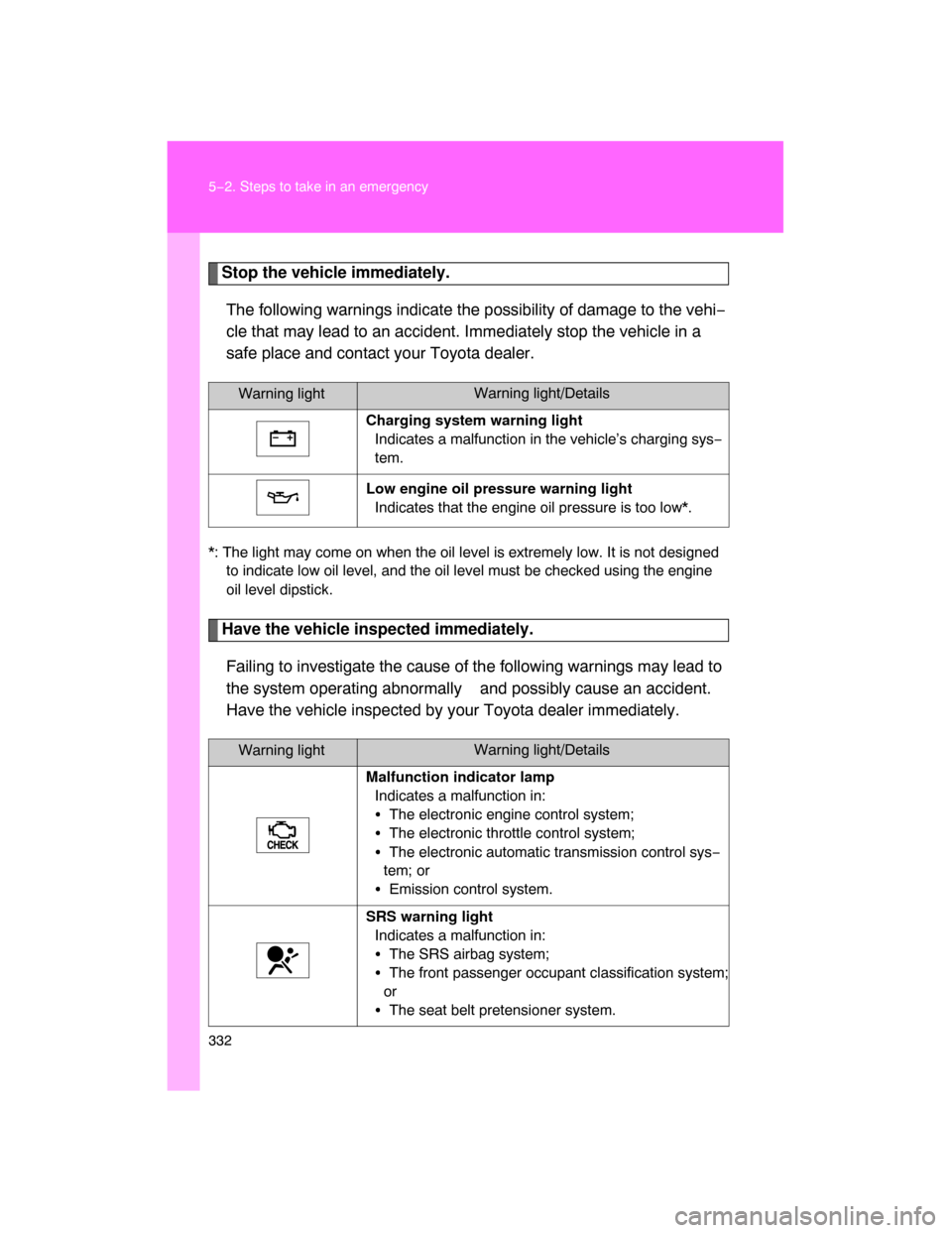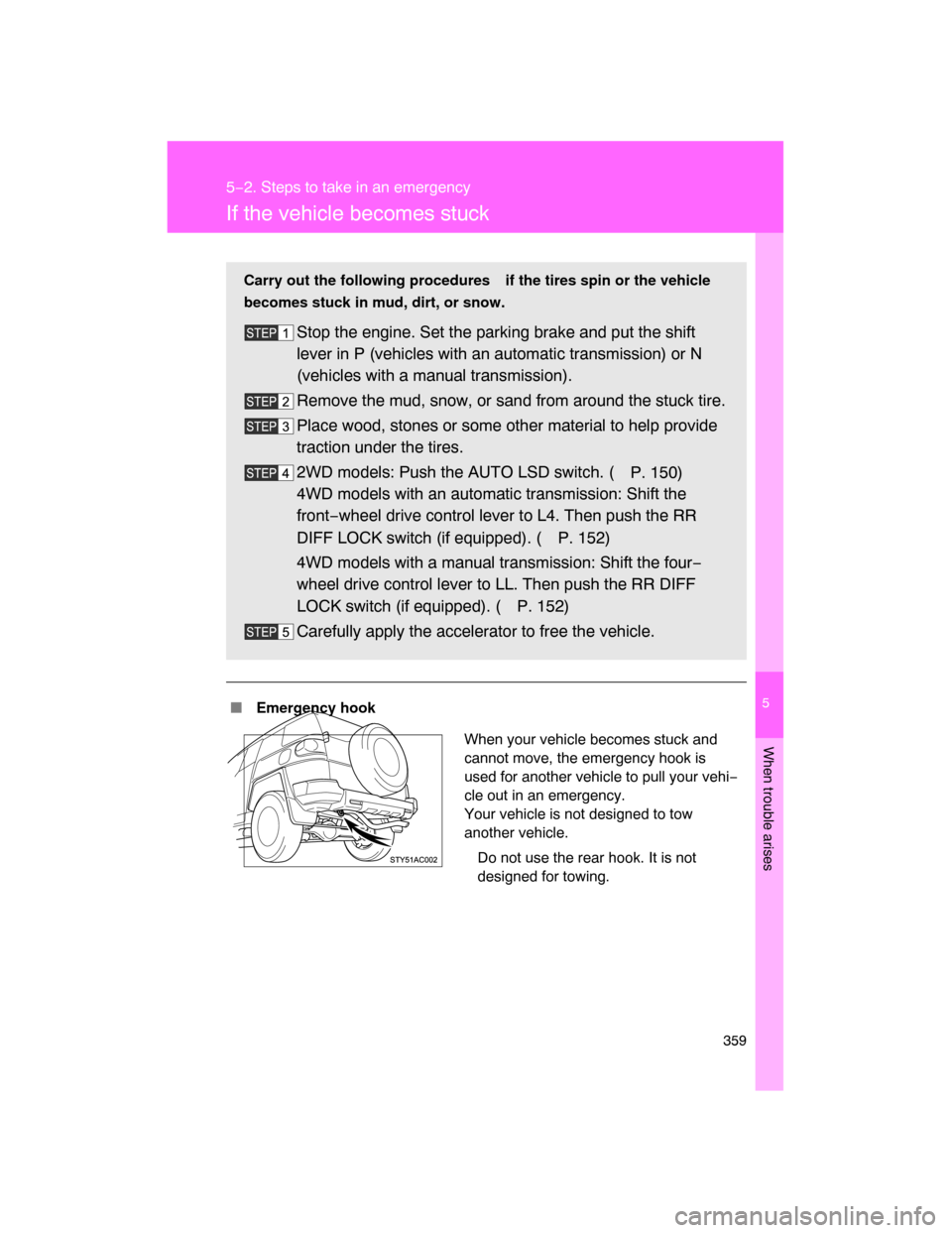Page 327 of 400

332 5−2. Steps to take in an emergency
Stop the vehicle immediately.
The following warnings indicate the possibility of damage to the vehi−
cle that may lead to an accident. Immediately stop the vehicle in a
safe place and contact your Toyota dealer.
*: The light may come on when the oil level is extremely low. It is not designed
to indicate low oil level, and the oil level must be checked using the engine
oil level dipstick.
Have the vehicle inspected immediately.
Failing to investigate the cause of the following warnings may lead to
the system operating abnormally
and possibly cause an accident.
Have the vehicle inspected by your Toyota dealer immediately.
Warning lightWarning light/Details
Charging system warning light
Indicates a malfunction in the vehicle’s charging sys−
tem.
Low engine oil pressure warning light
Indicates that the engine oil pressure is too low*.
Warning lightWarning light/Details
Malfunction indicator lamp
Indicates a malfunction in:
�The electronic engine control system;
�The electronic throttle control system;
�The electronic automatic transmission control sys−
tem; or
�Emission control system.
SRS warning light
Indicates a malfunction in:
�The SRS airbag system;
�The front passenger occupant classification system;
or
�The seat belt pretensioner system.
Page 328 of 400
5
When trouble arises
333 5−2. Steps to take in an emergency
(U.S.A.)
(Canada)ABS warning light
Indicates a malfunction in:
�The ABS; or
�The brake assist system.
VSC/TRAC warning light
Indicates a malfunction in:
�The vehicle stability control system;
�The traction control system;
�The active traction control system (if equipped); or
�The AUTO LSD system (2WD models).
(Automatic transmis−
sion vehicles)Automatic transmission fluid temperature warn�
ing light
Indicates that the automatic transmission fluid tem−
perature is too high.
(if equipped)Unengaged “Park” warning light
Malfunction in the transmission “Park” mechanism.
Warning lightWarning light/Details
Page 335 of 400
340
5−2. Steps to take in an emergency
If you have a flat tire
Remove the flat tire and replace it with the spare provided.
� Before jacking up the vehicle
� Stop the vehicle on a hard, flat surface.
�Set the parking brake.
�
Shift the shift lever to P (automatic transmission) or R (manual
transmission).
� Stop the engine.
�Turn on the emergency flashers.
�
Location of the spare tire, jack and tools
Tool bag
Spare tire
Jack
Page 354 of 400

5
When trouble arises
359
5−2. Steps to take in an emergency
If the vehicle becomes stuck
� Emergency hook Carry out the following procedures if the tires spin or the vehicle
becomes stuck in mud, dirt, or snow.
Stop the engine. Set the parking brake and put the shift
lever in P (vehicles with an automatic transmission) or N
(vehicles with a manual transmission).
Remove the mud, snow, or sand from around the stuck tire.
Place wood, stones or some other material to help provide
traction under the tires.
2WD models: Push the AUTO LSD switch. (
P. 150)
4WD models with an automatic transmission: Shift the
front−wheel drive control lever to L4. Then push the RR
DIFF LOCK switch (if equipped). ( P. 152)
4WD models with a manual transmission: Shift the four−
wheel drive control lever to LL. Then push the RR DIFF
LOCK switch (if equipped). ( P. 152)
Carefully apply the accelerator to free the vehicle.
When your vehicle becomes stuck and
cannot move, the emergency hook is
used for another vehicle to pull your vehi−
cle out in an emergency.
Your vehicle is not designed to tow
another vehicle.
Do not use the rear hook. It is not
designed for towing.
Page 355 of 400
360 5−2. Steps to take in an emergency
CAUTION
� When attempting to free a stuck vehicle
If you choose to rock the vehicle back and forth to free it, make sure the sur−
rounding area is clear, to avoid striki
ng other vehicles, objects or persons.
The vehicle may also lunge forward or lunge back suddenly as it becomes
free. Use extreme caution.
� When shifting the shift lever
Vehicles with automatic transmission: Be careful not to shift the shift lever
with the accelerator pedal depressed.
This may lead to unexpected rapid acceleration of the vehicle that may
cause an accident and result in death or serious injury.
NOTICE
� To avoid damaging the transmission and other components
� Avoid spinning the wheels and do not rev the engine.
�
If the vehicle remains stuck after trying these procedures, the vehicle may
require towing to be freed.
Page 360 of 400
366 6−1. Specifications
Cooling system
Ignition system
Electrical system
Capacity
Vehicles with an automatic transmission
10.4 qt. (9.8 L, 8.6 Imp.qt.)
Vehicles with a manual transmission
9.9 qt. (9.4 L, 8.3 Imp. qt.)
Coolant typeUse either of the following.
�“Toyota Super Long Life Coolant”
�Similar high−quality ethylene glycol−based
non−silicate, non−amine, non−nitrite, and
non−borate coolant with long−life hybrid
organic acid technology
Do not use plain water alone.
Spark plug
Make DENSO
NGK
K20HR−U11
LFR6C11
Gap 0.043 in. (1.1 mm)
Battery
Open voltage at
68
F (20 C):12.6 12.8 V Fully charged
12.2 12.4 V Half charged
11 . 8 12.0 V Discharged
(Voltage checked 20 minutes after
the key is removed with all the lights
turned off)
Charging rates 5 A max.
Page 361 of 400

367
6−1. Specifications
6
Vehicle specifications
Differential
Automatic transmission
*: The fluid capacity is the quantity of reference. If replacement is necessary,
contact your Toyota dealer.
Oil capacityFront
(4WD models)
Vehicles with a manual transmission
1.5 qt. (1.4 L, 1.2 Imp.qt.)
Vehicles with an automatic transmission
1.7 qt. (1.6 L, 1.4 Imp.qt.)
Rear
Vehicles with a rear differential lock
3.1 qt. (2.9 L, 2.6 Imp.qt.)
Vehicles without a rear differential lock
3.2 qt. (3.0 L, 2.6 Imp.qt.)
Oil type and
viscosityFront
(4WD models)Hypoid gear oil API GL−5
Vehicles with an automatic transmission
SAE75W−85
Vehicles with a manual transmission
Above 0
F (−18C): SAE90
Below 0
F (−18
C): SAE80W or 80W−90
RearHypoid gear oil API GL−5
Above 0 F (−18C): SAE90
Below 0
F (−18
C): SAE80W or 80W−90
Fluid capacity
*11.3 qt. (10.7 L, 9.4 Imp.qt.)
Fluid type Toyota Genuine ATF WS
NOTICE
� Automatic transmission fluid type
Using automatic transmission fluid other than “Toyota Genuine ATF WS”
may cause deterioration in shift quality, locking up of your transmission
accompanied by vibration, and ultimately damage the automatic
transmission of your vehicle.
Page 362 of 400
368 6−1. Specifications
Manual transmission
Clutch
Transfer (4WD models)
Gear oil capacity (Reference) 1.9 qt. (1.8 L, 1.6 Imp.qt.)
Gear oil type Gear oil API GL−4 or GL−5
Recommended gear oil viscosity SAE 75W−90
Clutch free play 0.2 0.6 in. (5
15 mm)
Fluid type FMVSS No. 116 DOT 3 or SAE J1703
Oil capacity
Vehicles with an automatic transmission
1.1 qt. (1.0 L, 0.9 Imp.qt.)
Vehicles with a manual transmission
1.5 qt. (1.4 L, 1.2 Imp.qt.)
Oil type
Vehicles with an automatic transmission
Hypoid gear oil API GL−4 or GL−5
Vehicles with a manual transmission
Hypoid gear oil API GL−5
Recommended oil viscosity SAE 75W−90